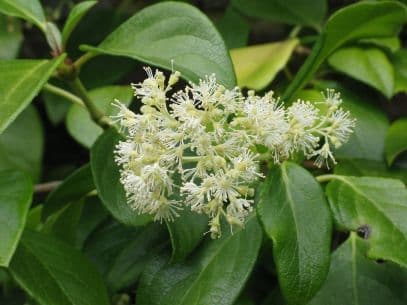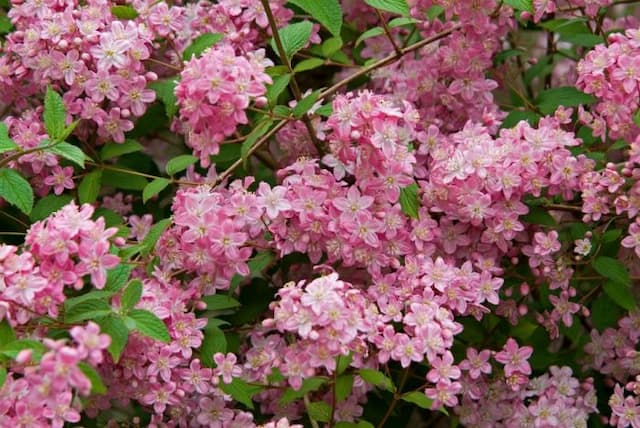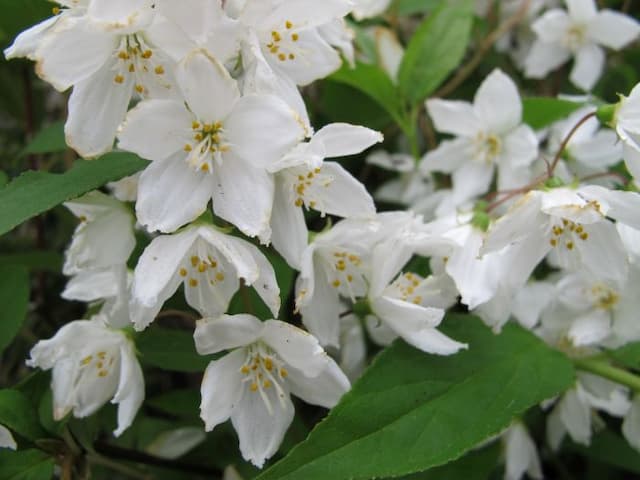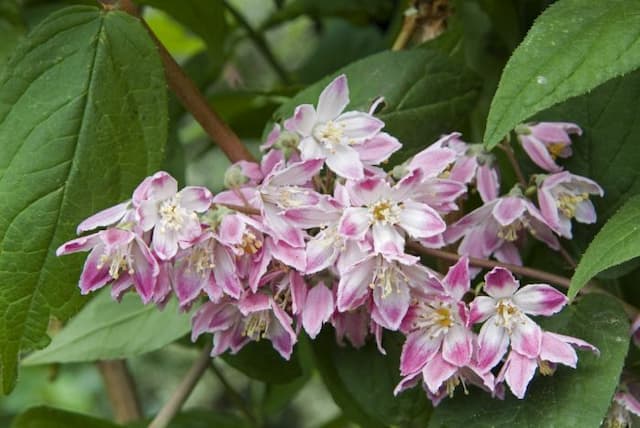Mountain Hydrangea Hydrangea serrata 'Shichidanka' (L/d)

ABOUT
The Hydrangea serrata 'Shichidanka' is a beautiful ornamental plant widely admired for its lush foliage and breathtaking flowers. The leaves of this hydrangea are notably toothed on the edges, adding a finely textured appearance to the plant's overall look. They exhibit a rich green color that provides a deep backdrop for the plant's flowers. These flowers are perhaps the most striking feature of the 'Shichidanka'. They typically bloom in rounded clusters known as corymbs or large, flat-topped flower heads. Each cluster is made up of both small fertile florets and larger, showy sterile flowers. The blossoms range in color from shades of blue to pink, often influenced by the soil's acidity; more acidic soils tend to produce bluer flowers, while alkaline soils can result in pinker hues. The inflorescence of the ‘Shichidanka’ is quite a sight when in full bloom, providing a soft yet vibrant palette that can easily become the centerpiece of any garden display. The flowers have the ability to change color as they age, adding a dynamic quality to the visual appeal of the hydrangea. Blooming typically occurs from early to mid-summer, which is when this plant reveals its utmost beauty. This hydrangea offers a delicate charm with its detailed appearance — from the texture of its leaves to the intricate flowers that captivate onlookers. It is a plant that both amateur and expert gardeners treasure for its decorative appeal and the enchantment it brings to any landscape setting.
About this plant
 Names
NamesFamily
Hydrangeaceae
Synonyms
Mountain Hydrangea, Tea Of Heaven
Common names
Hydrangea serrata 'Shichidanka'
 Toxicity
ToxicityTo humans
Hydrangea, the common name of Hydrangea serrata 'Shichidanka', contains a compound called hydrangenol which can be toxic if ingested. The toxicity level is generally considered low; however, if large quantities are consumed, it can lead to symptoms such as nausea, vomiting, and diarrhea. In some cases, more severe reactions can include dizziness and confusion. Cyanide intoxication is also a risk with hydrangeas as the plant parts contain cyanogenic glycosides, which can release cyanide in the body. Ingesting any part of the plant, especially the buds and leaves, should be avoided to prevent these toxic effects.
To pets
Hydrangea, the common name of Hydrangea serrata 'Shichidanka', is also toxic to pets such as dogs and cats. The toxic principles in the plant are hydrangenol and cyanogenic glycosides. When ingested, pets can experience symptoms like vomiting, diarrhea, lethargy, and depression. More severe toxicity can result in confusion, cardiovascular collapse, and even seizures. It's important to prevent pets from consuming any part of the hydrangea plant to avoid these potentially harmful consequences. If a pet ingests hydrangea, it's recommended to contact a veterinarian immediately.
 Characteristics
CharacteristicsLife cycle
Perennials
Foliage type
Deciduous
Color of leaves
Green
Flower color
Blue
Height
2-4 feet (0.6-1.2 meters)
Spread
2-4 feet (0.6-1.2 meters)
Plant type
Shrub
Hardiness zones
6
Native area
Japan
Benefits
 General Benefits
General Benefits- Aesthetic Appeal: Produces beautiful lacecap flower heads in shades of blue, pink, or purple adding visual interest to the garden.
- Seasonal Interest: Offers a long flowering period from late spring to early autumn, enriching garden aesthetics across seasons.
- Attracts Pollinators: Provides nectar for bees and other pollinators, supporting biodiversity and the local ecosystem.
- Versatility in Landscape: Can be used for a variety of garden designs, including borders, foundations, and as a focal point in a mixed shrub border.
- Tolerant of Acidic Soils: Thrives in acidic soil conditions where other plants may struggle, allowing for diverse planting options.
- Moderate Growth Rate: Grows at a manageable pace which reduces the need for frequent pruning and maintenance.
- Shade Tolerance: Capable of growing in partial shade, offering flexibility in garden placement and expanding landscaping options.
 Medical Properties
Medical Properties- Antimalarial: Extracts from the plant have been studied for potential antimalarial properties.
- Anti-inflammatory: The hydrangea has been traditionally used for its anti-inflammatory effects in folk medicine.
- Diuretic: Traditionally, the hydrangea has been used as a diuretic to increase urine flow.
- Antilithic: The plant has usage in traditional medicine for preventing and aiding in the treatment of kidney stones.
 Air-purifying Qualities
Air-purifying QualitiesThis plant is not specifically known for air purifying qualities.
 Other Uses
Other Uses- As a natural pH indicator: Hydrangea serrata's flower color can indicate the pH level of the soil in which it is planted, with shades ranging from pink to blue.
- In fabric dyeing: The flowers of the plant can be used to create a natural dye, which can impart beautiful hues to fabrics.
- In crafts and decoration: Dried hydrangea flowers are popular for use in wreaths, bouquets, or as standalone decorations due to their long-lasting and vibrant blooms.
- As a symbolism in weddings: Hydrangeas are often used in wedding bouquets and decorations to symbolize grace, beauty, and abundance.
- As a cold compress: The cooled down leaves of hydrangeas have traditionally been used as a makeshift cold compress for minor bumps or bruises.
- In culinary presentations: The blossoms of hydrangea can be used to add a splash of color as garnishes on plates or in drinks, though they are not edible.
- As an inspiration in art: Due to its vibrant colors and complex shapes, Hydrangea serrata is frequently depicted in paintings, prints, and textiles.
- In educational gardens: This plant is used as an educational tool in botanical gardens to teach about soil chemistry and plant coloration.
- For soil improvement: When decomposed, the leaves and plant debris of Hydrangea serrata can be incorporated into compost or mulch to enrich garden soil.
- In photography: Because of their striking appearance, hydrangeas are often the subject of photography, being favored by both amateur and professional photographers for their aesthetic appeal.
Interesting Facts
 Feng Shui
Feng ShuiThe mountain hydrangea is not used in Feng Shui practice.
 Zodiac Sign Compitability
Zodiac Sign CompitabilityThe mountain hydrangea is not used in astrology practice.
 Plant Symbolism
Plant Symbolism- Heartfelt emotions: Hydrangeas are often associated with the expression of genuine, heartfelt emotions, due to their lush and abundant flowerheads.
- Gratitude: In some cultures, hydrangeas represent gratitude for being understood or for the recipient's understanding and patience.
- Apology: Hydrangeas can symbolize an apology, suggesting a desire for reconciliation or expression of regret.
- Frigidity or Heartlessness: Some interpretations suggest that hydrangeas symbolize frigidity or heartlessness, reflecting the historical belief that they were associated with boastfulness.
- Abundance: The full, abundant blooms of hydrangeas symbolize abundance and prosperity.
- Perseverance: Hydrangea serrata, being a mountain variety, often symbolizes perseverance and determination to survive in harsh conditions.
- Vanity: Due to their showy appearance, in certain Victorian interpretations, hydrangeas could symbolize vanity and narcissism.
- Femininity: The soft, round shape of the hydrangea flowers has been associated with female energy and grace.
 Water
WaterThe Mountain Hydrangea should be watered deeply to ensure the roots get enough moisture, usually every week, but this can vary depending on climate conditions. During hot or dry periods, increase the frequency to two or three times a week. Ensure that you're providing approximately one to one and a half gallons of water per plant during each watering session. Always check the soil moisture before watering; it should be moist but not saturated. During the winter months, reduce watering as the plant requires less moisture due to cooler temperatures and dormancy.
 Light
LightMountain Hydrangeas prefer dappled sunlight or part shade, especially in the heat of the afternoon. The best spot for these hydrangeas would be one where they receive morning sunlight and are protected from the intense sun later in the day. Too much direct sunlight can lead to leaf scorch, while too little can reduce blooming.
 Temperature
TemperatureMountain Hydrangeas thrive in temperatures between 60°F and 75°F, which are ideal for promoting growth and flowering. They can tolerate a minimum winter temperature of around 5°F, but frost can damage the buds and flowers if not protected. During the summer, consistent temperatures below 95°F are best to avoid heat stress.
 Pruning
PruningPruning Mountain Hydrangeas is best done immediately after blooming to shape the plant and encourage next year's flower buds. Removing spent blooms and dead branches can be done at any time. It is advisable to prune no later than the end of August, as pruning later can inadvertently remove the developing flower buds for the next season.
 Cleaning
CleaningAs needed
 Soil
SoilMountain Hydrangea prefers moist, well-draining soil with high organic matter. The ideal pH for this plant is acidic, ranging from 5.5 to 6.5. A good mix would be one part peat moss, one part compost, and one part perlite or pine bark fines.
 Repotting
RepottingMountain Hydrangea should be repotted every 2-3 years or when it becomes root-bound to promote healthy growth and flowering. Spring is the best time to repot this plant.
 Humidity & Misting
Humidity & MistingMountain Hydrangea thrives in moderate to high humidity levels, ideally between 50% to 70%. Avoid placing it in excessively dry environments.
 Suitable locations
Suitable locationsIndoor
Place in bright indirect light with high humidity.
Outdoor
Part shade, moist soil, shelter from harsh sun.
Hardiness zone
6-9 USDA
 Life cycle
Life cycleHydrangea serrata 'Shichidanka', commonly known as mountain hydrangea, begins its life cycle as a dormant seed during the winter. In early spring, the seed germinates and a seedling emerges, utilizing stored energy to grow roots and shoots. Throughout spring and summer, the plant experiences vegetative growth, developing a strong root system, foliage, and stems. By late spring to early summer, the mountain hydrangea enters its flowering stage, producing clusters of delicate pink to blue flowers, depending on soil pH, which attract pollinators and may lead to seed formation if fertilization occurs. Following the blooming period, seeds develop within the flowers, and as autumn approaches, the plant begins to enter dormancy, conserving energy and resources for the next growing season. Over the years, with each cycle, the plant matures, grows larger, and produces more abundant flowers.
 Propogation
PropogationPropogation time
Spring-Early Summer
Hydrangea serrata 'Shichidanka', commonly known as the Mountain Hydrangea, is typically propagated by softwood or semi-hardwood cuttings during late spring to early summer. The most popular method involves taking healthy, non-flowering shoots of about 4 to 6 inches long (10-15 cm) with at least three sets of leaves. These cuttings are then dipped in rooting hormone to encourage root development and planted in a mixture of peat and perlite or a sterile potting mix. The cuttings should be kept under high humidity, either in a greenhouse or under a plastic cover, and in indirect light. Roots usually develop within 4 to 8 weeks, after which the new plants can be gradually acclimatized to outdoor conditions before planting out.






![Rose deutzia [Yuki Cherry Blossom]](/_next/image?url=https%3A%2F%2Fplants-admin.emdemapps.com%2Fimages%2Fplants%2F%2Fimages%2F604b6510a383a.png&w=640&q=75)
![Hydrangea [Hot Chocolate]](/_next/image?url=https%3A%2F%2Fplants-admin.emdemapps.com%2Fimages%2Fplants%2F%2Fimages%2F604b5a066e3bd.png&w=640&q=75)
![Hydrangea [Blackberry Pie]](/_next/image?url=https%3A%2F%2Fplants-admin.emdemapps.com%2Fimages%2Fplants%2F%2Fimages%2F604b56e2abc1d.png&w=640&q=75)
